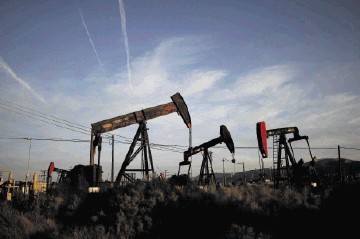
Brent and West Texas Intermediate fell to a five-year low as Iraq followed Saudi Arabia in cutting prices for crude sales to Asia, adding to signs that OPEC’s biggest members are defending market share.
Futures dropped as much as 1.3%t in London to the weakest intraday price since September 2009.
Iraq, the second-largest producer in the Organization of Petroleum Exporting Countries, reduced its Basrah Light crude to the lowest in at least 11 years, a price list for January showed.
Oil will remain at about $65 a barrel for half a year until OPEC’s output changes or demand expands, according to Kuwait Petroleum Corp.
Crude is trading in a bear market as the highest US production in three decades exacerbates a global glut.
Saudi Arabia, which led OPEC’s decision to maintain rather than cut output at a November 27 meeting, last week offered supplies to its Asian customers at the deepest discount in at least 14 years.
“If you want to move product, you discount it,” David Lennox, a resource analyst at Fat Prophets in Sydney, said by phone today. “That is going to continue. Until there are cuts to production, there could be more pain to come.”
Brent for January settlement declined as much as 86 cents to $65.33 a barrel on the London-based ICE Futures Europe exchange and was at $65.54 at 1:39 p.m. Singapore time. It slid $2.88 to $66.19 yesterday, the lowest close since September 2009.
The European benchmark crude traded at a premium of $2.89 to WTI. Prices are down 41% this year.
WTI for January delivery decreased as much as 80 cents, or 1.3%, to $62.25 a barrel in electronic trading on the New York Mercantile Exchange.
The contract lost $2.79 to $63.05 yesterday, the lowest since July 2009. Total volume was about 23% above the 100-day average.
Iraq’s Oil Marketing Co. will sell Basrah Light to Asia at $4 a barrel below the average of Middle East benchmark Oman and Dubai grades, the steepest discount since August 2003. The company reduced prices to US buyers by 30 cents and marked up shipments to Europe by 10 cents.
Middle East producers including Iraq, Iran and Kuwait typically follow Saudi Arabia’s lead when setting crude export prices. The kingdom is the biggest member of OPEC, which supplies about 40% of the world’s crude.
“Oil prices will stay around the current level of $65 for six or seven months until OPEC changes its production policy, or recovery in world economic growth become more clear, or a geopolitical tension arises,” Nizar Al-Adsani, Kuwait Petroleum’s chief executive officer, said.
The nation is the third-largest among OPEC’s 12 members.
The group pumped 30.56 million barrels a day in November, exceeding its collective target of 30 million for a sixth straight month, according to a survey of companies, producers and analysts.
The US oil boom has been driven by a combination of horizontal drilling and hydraulic fracturing, which has unlocked supplies from shale formations including the Eagle Ford in Texas and the Bakken in North Dakota.
Production increased to 9.08 million barrels a day through November 28, the fastest rate in weekly records that started in January 1983, data from the Energy Information Administration showed.
Crude stockpiles in the country, the world’s biggest oil consumer, probably shrank by 2.5 million barrels last week, according to the median estimate in a separate survey of seven analysts. That would be a second weekly drop.
Recommended for you
